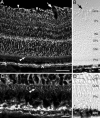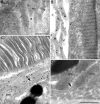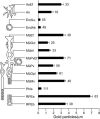Carbonic anhydrase XIV is enriched in specific membrane domains of retinal pigment epithelium, Muller cells, and astrocytes
- PMID: 15901897
- PMCID: PMC1142392
- DOI: 10.1073/pnas.0503021102
Carbonic anhydrase XIV is enriched in specific membrane domains of retinal pigment epithelium, Muller cells, and astrocytes
Abstract
Carbonic anhydrases (CAs) are ubiquitous enzymes important to many cell types throughout the body. They help determine levels of H(+) and HCO(-)(3) and thereby regulate intracellular and extracellular pH and volume. CA XIV, an extracellular membrane-bound CA, was recently shown to be present in brain and retina. Here, we analyze the subcellular distribution of CA XIV in retina by high-resolution immunogold cytochemistry and show that the distribution in retina (on glial cells but not neurons) is different from that reported for brain (on neurons but not glia). In addition, CA XIV is strongly expressed on retinal pigment epithelium (RPE). The specific membrane domains that express CA XIV were endfoot and nonendfoot membranes on Muller cells and astrocytes and apical and basolateral membranes of RPE. Gold particle density was highest on microvilli plasma membranes of RPE, where it was twice that of glial endfoot and Muller microvilli membranes and four times that of other glial membrane domains. Neither neurons nor capillary endothelial cells showed detectable labeling for CA XIV. This enrichment of CA XIV on specific membrane domains of glial cells and RPE suggests specialization for buffering pH and volume in retinal neurons and their surrounding extracellular spaces. We suggest that CA XIV is the target of CA inhibitors that enhance subretinal fluid absorption in macular edema. In addition, CA XIV may facilitate CO(2) removal from neural retina and modulate photoreceptor function.
Figures






Similar articles
-
Carbonic anhydrase XIV identified as the membrane CA in mouse retina: strong expression in Müller cells and the RPE.Exp Eye Res. 2005 Oct;81(4):492-500. doi: 10.1016/j.exer.2005.03.010. Exp Eye Res. 2005. PMID: 16126196
-
Membrane-bound carbonic anhydrase in human retinal pigment epithelium.Invest Ophthalmol Vis Sci. 1994 Aug;35(9):3401-7. Invest Ophthalmol Vis Sci. 1994. PMID: 8056514
-
Inhibition of membrane-bound carbonic anhydrase decreases subretinal pH and volume.Doc Ophthalmol. 1999;97(3-4):261-71. doi: 10.1023/a:1002496223131. Doc Ophthalmol. 1999. PMID: 10896339
-
The role of carbonic anhydrase inhibitors in the management of macular edema.Doc Ophthalmol. 1999;97(3-4):387-97. doi: 10.1023/a:1002143802926. Doc Ophthalmol. 1999. PMID: 10896355 Review.
-
[New aspects of ultracytochemical studies on blood-retinal barriers. II. Newly developed cytochemistry on retinal Müller cells and pigment epithelial cells for interpretation of their contributions in blood-retinal barrier].Nippon Ganka Gakkai Zasshi. 1988 Dec;92(12):1961-2014. Nippon Ganka Gakkai Zasshi. 1988. PMID: 2853570 Review. Japanese. No abstract available.
Cited by
-
pH in the vertebrate retina and its naturally occurring and pathological changes.Prog Retin Eye Res. 2025 Jan;104:101321. doi: 10.1016/j.preteyeres.2024.101321. Epub 2024 Nov 26. Prog Retin Eye Res. 2025. PMID: 39608565 Review.
-
Novel distribution of junctional adhesion molecule-C in the neural retina and retinal pigment epithelium.J Comp Neurol. 2007 Nov 10;505(2):166-76. doi: 10.1002/cne.21489. J Comp Neurol. 2007. PMID: 17853450 Free PMC article.
-
Carbonic anhydrase IV and XIV knockout mice: roles of the respective carbonic anhydrases in buffering the extracellular space in brain.Proc Natl Acad Sci U S A. 2005 Nov 15;102(46):16771-6. doi: 10.1073/pnas.0508449102. Epub 2005 Oct 31. Proc Natl Acad Sci U S A. 2005. PMID: 16260723 Free PMC article.
-
Bilateral macular edema secondary to nab-paclitaxel therapy for breast cancer.Int J Ophthalmol. 2024 Oct 18;17(10):1963-1966. doi: 10.18240/ijo.2024.10.26. eCollection 2024. Int J Ophthalmol. 2024. PMID: 39430033 Free PMC article. No abstract available.
-
CO2-induced ion and fluid transport in human retinal pigment epithelium.J Gen Physiol. 2009 Jun;133(6):603-22. doi: 10.1085/jgp.200810169. J Gen Physiol. 2009. PMID: 19468075 Free PMC article.
References
-
- Chesler, M. (2003) Physiol. Rev. 83, 1183–1221. - PubMed
-
- Wadiche, J. I., Amara, S. G. & Kavanaugh, M. P. (1995) Neuron 15, 721–728. - PubMed
-
- Magleby, K. L. (2004) Trends Neurosci. 27, 231–233. - PubMed
-
- Svichar, N. & Chesler, M. (2003) Glia 41, 415–419. - PubMed
-
- McMurtrie, H. L., Cleary, H. J., Alvarez, B. V., Loiselle, F. B., Sterling, D., Morgan, P. E., Johnson, D. E. & Casey, J. R. (2004) J. Enzyme Inhib. Med. Chem. 19, 231–236. - PubMed
Publication types
MeSH terms
Substances
Grants and funding
LinkOut - more resources
Full Text Sources
Other Literature Sources
Molecular Biology Databases

